 |
|||||
|
|||||
| Preview of Stamps Catalogue: VOLUME 1 |
 |
|||||
|
|||||
| Preview of Stamps Catalogue: VOLUME 1 |
Return To Catalogue - Suez Canal Company (Egypt) - Suez Canal Company, forgeries part 2 - Suez Canal Company, forgeries part 3, Spiro and Spiro-alike
Note: on my website many of the
pictures can not be seen! They are of course present in the catalogue;
contact me if you want to purchase it.
ATTENTION: most of the stamps found in collections are forgeries! This must be one of the most forged areas in philately. More than 20 different forgeries seem to exist of these stamps! Most forgeries require careful comparison with a genuine stamp, but with a little practise, most forgeries can be easily detected. For more forgeries: Suez Canal Company, forgeries part 2.
How to detect the forgeries? Firstly we can check the space between 'POSTES' and the oval. On most forgeries, the shading is vertical lines only. The real issues have cross-hatching:
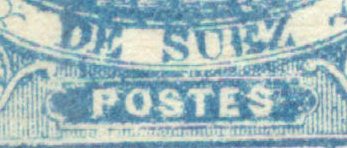
(Genuine stamp with cross-hatching)
Gum at the back is almost always cracked, forgeries don't have this, they always almost have smooth white gum (or no gum at all):

(Backside of a genuine 20 c, reduced size)
I found the following information at http://www.geocities.com/dr_k_fleming/suez.htm:
If your examples show any of the following characteristics, they are forgeries.
Perforated (the originals were imperforated) No cross hatching above POSTES smooth, colourless gum (a forgery if not a regummed stamp) thin, hard paper tan paper shiny ink (genuine stamps are matt) corner guide lines outside the design continuous guidelines between the stamps flat tops to the letters A any number of rays other than 12 in the star-like ornaments smoke from the funnel touches the oval frame circular cancellation of any kind (other than the Suez grid)

(The deck of a genuine stamp, image from R.J. Wilson)
Be awared of forged covers (even with genuine stamps!). Many
have a forged 5129 cancel; others are more "fanciful."
Some are on covers with the return address of the Suez Canal
company. Addresses can be fictitious. There are only 21 known
authentic covers.
For example, the forger Moustafe Ibrahim Bey is know to have made
forged letters (around 1925). The Ebay seller Saul50 is also
producing 'letters' (2015).
Reprint - forgeries also exist and are very
dangerous. They were made by Saatjian, a dealer in Paris of
Armenian origins, who obtained the
genuine stone for the red 40 c value around 1907, in an auction
for 80 Francs, after this stone had gone missing from the Suez
Canal Company's archives (also in Paris) and ended up in the
collection of the Paris stamp dealer Erard-Leroy d'Etiolles.
Saatjian modified this 40c to print the 1c, 5c and 20c values.
These 'reprints' do have the cross-hatching. Any 1 c or 5 c stamp
that shows the plating characteristics of the 40c, is a reprint.
These forgeries seems to have the wrong sort of gum
(shiney-smooth instead of brownish-crackled). As the genuine
stamps, the Saatjian forgeries do not have guidelines around the
stamps.
Strictly spoken, only the 40 c are true (though illegal) reprints
since the original plates were used. The other values should be
considered as forgeries.
Saatjian also made a second printing on brownish
paper, usually with bogus cancels, for example '..MO PORT-SAID
IH..', 'PORT SAID 2-1-14 2-4-5 PORT SAID', 'COLONIES', etc. These
cancels might have been applied by a certain Mr. M.S. from
Belgium (according to the Peter Bottrill collection)
Examples of a Saatjian reprint-forgeries:
The 1 c Saatjian forgeries all exhibit the characteristics of the first type of the 40 c (type A): Broken crossbar in 'T' OF "MARITIME" and long 'T' in "POSTES". Eight sub-types can be distinguished. Furthermore the 'C' of 'CANAL' has no tail:

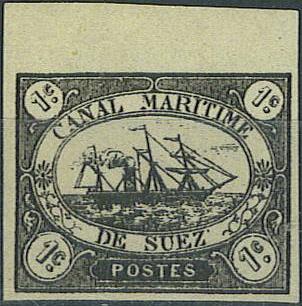
Saatjian forgery of the 1 c, note that these forgeries always
have a 'hole' in the funnel. The first forgery has in addition a
ragged upper circle in the lower left hand value tablet (subtype
3 of the 8 subtypes). Also note the appearance of a dot behind
'SUEZ' in some copies (in type 2 of the 8 subtypes).

Subtype 6 of the 1 c, the lower rope connecting the central to
the front mast has a few spurs in it.


Subtype 7, a dot above the upper frameline(?)
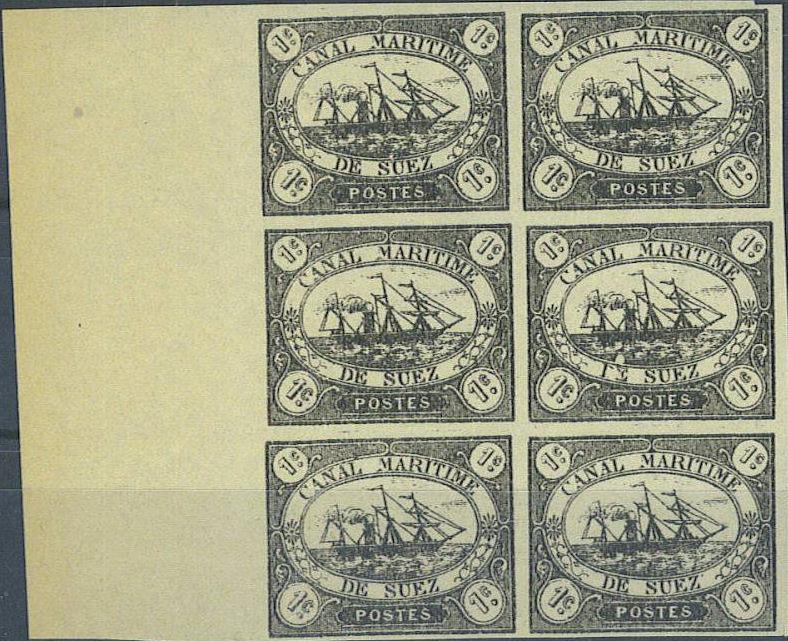
Subtypes 1-2, 5-6 and 1-2 of the 1 c value. Subtype 5 has a tiny
dot above the left star ornament.
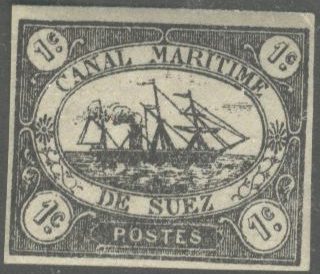
Most likely a Saatjian reprint as well.

5 c Saatjian reprints; subtypes 2 (smudges below 'DE") and 6
(break in the ellipse above to the right of 'Z' of 'SUEZ').

20 c with transfer type A(?) characteristics. I've noticed that
this type always(?) has a large top serif on top of the 'C' of
'CANAL'.


20 c with transfer type B characteristics; Dot between ropes at
front of ship.


20 c with transfer type C characteristics; broken T of POSTES and
broken line up to aft-mast on ship.




A Saatjian forgery, it has the characteristics of the 40 c; type
'D': thickened vertical in 'E' of "SUEZ", the cancel is
bogus. Note the white blotch on the middle of the ship (torpedo)
that I have seen on other Saatjian forgeries and is a
characteristic of this type. Also the two o'clock ray of the
right hand star is missing.

Block of 6 stamps, three type C transfer types (left column); one
type D (upper right) and 2 type A.

A strip of four 40 c Saatjian forgeries.






Forged cancels often found on Saatjian forgeries:
"COLONIES", "PORT SAID 2-1-14 2-4-5 PORT
SAID", parallel lines forming an ellipse.

These forgeries also exist pasted on pieces of paper. Here all 4
of them with "PORT SAID 2-1-14 2-4-5 PORT SAID"
cancels.
For more information see also: http://www.philatoforge.co.uk/CSSuezCanalCompany1868_Forgeries_Forgery08.html.
The smoke goes all the way to the containing ellipse. The ship is considerably different when compared to a genuine stamp. The vertical background lines are too coarse when compared to a genuine stamp. The 'M' and 'R' of 'MARITIME' are different from the genuine stamps. It often appears with two cancels, a 5-ring concentric ring cancel, probably initially applied by Kamigata (similar to his forged cancels of Korea) and then further 'enhanced' with a second cancel, perhaps by another forger or reseller?


Some of these forgeries have two cancels, one 5-ring cancel and a
'PORT-SAID' cancel that can also be found on the Saatjian
forgeries (always only part of the cancel, never the entire
cancel).
In the above forgeries, there is nobody on deck! Moreover the smoke touches the oval and between 'DE SUEZ' and 'POSTES' are only vertical lines. Note that the bow is different from the genuine stamps as well (it is pointing too much upwards).
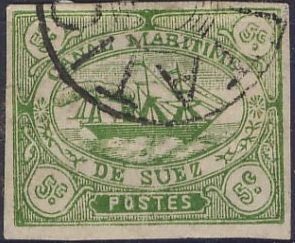




This forgery has a cancel "IMITATION" and was made by
the forger Kamigata of Japan. All
four values were forged by Kamigata. Also shown above are three
Kamigata forgeries, which were further 'enhanced' with a
"PORT SAID 15 VI 89" cancel.

A forgery in the wrong colour: 1 c green! The vertical background
lines are too coarse.

Another Kamigata forgery, image obtained from
http://www.philatoforge.co.uk/CSSuezCanalCompany1868_Forgeries_Forgery17.html.
The design is different from the above forgeries (as is often the
case with Kamigata forgeries, he made many varieties). It can
still be recognized though, since it has his typical
"IMITATION" cancel.
At first sight this looks like a Kamigata product as well, but it is clearly different. The most noticeable is the ropes at the back of the ship that form a large triangle.
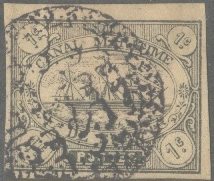

According to the Peter Bottrill collection, this Arabic cancel is
based on a coin from Zanzibar (1 Pessa from 1882)


Another 'coin-cancel', according to Peter Bottrill this is a
Roman coin from the Mint at Thessalonica (around 330 BC). The
design of the coin depicts a gate.

'PORT-SAID DOUANE COLIS IV T5' forged cancel.
The forgeries above resemble the 1 cents forgeries just described, but now people are added on deck. Note that again the bow is different from the genuine stamps as in the above forgeries. The ship has a wavy top flag. Some of the above forgeries have a forged '5129' cancel. This forgery type also exist with an Arabic cancel. It also exists with a 'ENTREPRISE GENERALE DES TRAVAUX' cancel in a large circle. Also shown above are a '125' numeral cancel and some dot cancels and an Arabic coin-cancel applied to the same forgery type. These forgeries were printed in sheets of 120.



Specialists distinguish five subtypes of the 40 c: in the first
on the upper left '40c' is placed higher. In the second one, the
dot of the lower right '40c' is connected to the '0'. In the
third type the dot behind the lower right '40c' has become a
comma. In the fourth type, this dot is even smaller. In the fifth
type, the 'c' of the lower right '40c' is broken at the left and
there is a smudge on the front of the ship.
I have my strong doubts about the following stamps:
Literature:
Unfortunately I haven't been able to read any of the above books or articles.
Websites: